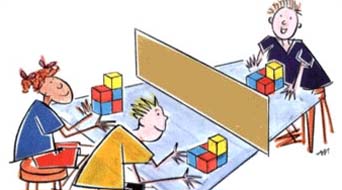4. In the classroom
There are many possible strategies for making more use of visualisation within the mathematics classroom. There are several visualisation activities for you to experiment with in Activity 3. One teacher's approach to incorporating visualisation is given in the following case study and three-part video clip.
Case study
In a secondary-school classroom, the teacher, Peter Gates, is working with fourteen-year-old students on a topic in which they are exploring aspects of circles. This particular activity involves working out distances around a race-track.
The school is Brindley Hall, at Stantonbury Campus, Milton Keynes. Peter has a class of 27 mixed-ability students. They are his own class for pastoral purposes and he teaches them mathematics. They work on an individualised scheme, the Kent Mathematics Project (KMP) for roughly half of their mathematics lessons and participate in whole-class projects, such as the one on circles, for the other lessons. These projects help to prepare students for their GCSE coursework that they will have to undertake in subsequent years.
The video clip has a three-part structure; view the three parts now by clicking on the links in the list below.
-
Introducing the problem.
Click on the 'play' button below to view the video
Transcript: Video 1
-
Two groups of students working on the problem.
Click on the 'play' button below to view the video
Transcript: Video 2
-
Reporting back.
Click on the 'play' button below to view the video
Transcript: Video 3
The students are encouraged to devise their own approaches to problems and to follow their own ideas and questions. Peter is concerned to involve the students in the mathematics they encounter, so that it becomes as meaningful as possible for them. He uses a number of devices in order to achieve this, one of which invokes their mental imagery to help them ‘see’ into a problem. Use of practical apparatus and calculators is also important to their way of working.
Activity 3
Visualisation is an important facet in all areas of the curriculum. Many people argue that we visualise what we have seen, but all our senses may be important. There are many resources that actively promote visualisation in the classroom.

In the classroom activity illustrated here the students design a solid from a few coloured cubes and then describe it. The others in the group then try to visualise the configuration and make their own.
You might like to try this activity in your classroom.
Further classroom activities for visualisation are available by clicking on the ‘view document’ and website links below. Explore some of these with colleagues and identify two or three to try out in class.
Click 'view document' below to download Diagrams.
View document [Tip: hold Ctrl and click a link to open it in a new tab. (Hide tip)]
Click 'view document' below to download The feely box.
Click 'view document' below to download The hundred square.
Click 'view document' below to download Number lines.
Click 'view document' below to download People activities.
Click 'view document' below to download Photographs.
Click 'view document' below to download Tracing paper.
The Key Stage 3 National Strategy website.
Multiples and factors: assessing pupils' work website.
